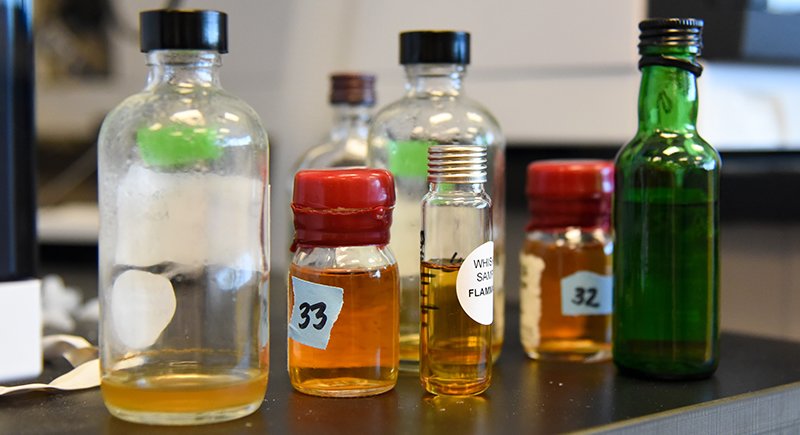
June 26, 2017 New distilled spirits analysis earns WSU team top honors at world conference
RICHLAND, Wash. – A team from Washington State University recently took home top honors in the research poster competition at the Worldwide Distilled Spirits Conference in Glasgow, Scotland, for research on a technique typically used to evaluate the characteristics of wine.
To determine the characteristics and compounds in wine, researchers combine a wine sample with a mixture of water and octanol, which is a fatty alcohol. As a result, different compounds from the wine separate and enter into two phases: octanol and water. The relative separation of the compounds into the two phases is known as the beverage’s hydrophobicity.
These two phases are then analyzed using mass spectrometry, a sophisticated technique that identifies the individual compounds within those phases. The identified compounds can help determine the astringency, or mouth feel, of the wine as well as the color and other sensory factors.
Wine scientists expand applications

The WSU Tri-Cities team, which consisted of wine science postdoctoral researcher Caroline Merrell, associate professor of enology Jim Harbertson, and assistant professor of wine science Tom Collins, decided to analyze distilled spirits using the same process.
“It started off as ‘let’s see what happens when we apply this technique to a product other than wine,’” Collins said. “Spirits make sense for this analysis not only because of their similarities to wine, but also their differences. We expected to extract different things from the barrels for spirits than for wine, and I think we clearly see that with our findings.”
A measurement in wine is used primarily to evaluate phenolic composition, Harbertson said. The phenolic composition, derived from the grapes and barrels, affects the taste, color and mouthfeel of wine.
“But in spirits, the phenolics are only derived from the barrel, so the process provides an interesting piece of the puzzle,” he said.
Whiskey, tequila, rum, cognac
In their research, team members examined a range of distilled spirits including American whiskey (bourbon), Scotch whiskey, Irish whiskey, tequila, rum, cognac and Armagnac. The barrel type used in the aging process for these spirits significantly impacted the identified compounds, Merrell said.
“For instance, all the bourbons separated out together as part of the statistical analysis,” she said. “Bourbon is made in new, heavily charred barrels. Because bourbons use newly charred barrels, there is more extraction of different phenolic and flavor compounds during aging. All the other spirit types age in previously used barrels, which have already had substantial amounts of phenolic and flavor compounds extracted.”
Barrel selection insights
Their initial research shows the importance of barrel selection in making distilled spirits. The hope is that it will give the industry more tools for making alcohol, Merrell said.
“Our research gives the industry more insight into the effects of barrel selection for different types of spirits,” Collins said. “We had a fair amount of interest from distilleries after the presentation, and we look forward to opportunities to collaborate and explore these effects in more detail.”
The team hopes to expand their research beyond commercially available products. The plan is to acquire distillation equipment at the Ste. Michelle Wine Estates WSU Wine Science Center to prepare, develop and analyze their own spirits.
To his knowledge, this is the first time anyone has used the hydrophobicity technique to examine the components of distilled spirits, Collins said.
Media Contacts:
- Tom Collins, WSU Tri-Cities assistant professor of wine science, 509-372-7515, tom.collins@wsu.edu
- Jim Harbertson, WSU Tri-Cities associate professor of enology, 509-372-7506, jfharbertson@wsu.edu
- Caroline Merrell, WSU Tri-Cities viticulture and enology postdoctoral researcher, 509-372-7518, caroline.merrell@wsu.edu
- Maegan Murray, WSU Tri-Cities public relations specialist, 509-372-7333, maegan.murray@tricity.wsu.edu





